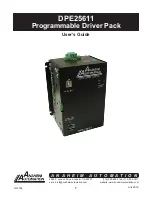
August 2012
L010796
11
Move Number of Steps:
This command causes the motion to start in the direction last specified.
This command will move the motor the number of steps given. (Range: 1 to 8388607)
Move to Position:
The move to position command specifies the next absolute position to go to. The
DPE25611 controller automatically sets the direction and number of steps needed to go to that posi-
tion. (Range: -8388607 to +8388607)
Slew:
The slew command will accelerate the motor up to maximum speed and continue to run at
that speed until reaching a registration mark, hard limit switch, soft limit switch, receiving a “.” (stop
hard) or “,” (stop soft) command.
Set Position:
The set position command sets the position register to a designated value. The number
will be the new absolute position of the motor. The default value is 0. (Range: -8388607 to +8388607)
Limit Switch Inputs:
The limit switch inputs are internally pulled up by a resistor making them normally
+5V. To activate the input, the pin must be grounded to (0VDC). All limit switch inputs are internally
clamped to +5V, thus allowing voltages of up to +24VDC to be used.
Hard Limit Inputs:
When a hard limit switch is encountered, the motion will stop immediately. The
position counter will also cease counting.
Hard limits are intended as an emergency stop for your
system. It should not be used to do any positioning type functions.
These limits are directional.
Soft limit Inputs:
These switches should be used exclusively for homing. Once positioned properly
with the appropriate parameters, it causes the motor to ramp down to the base speed before encoun-
tering the home limit switch. However, the soft limit switch will work for any type of motion command.
These limits are directional.
NOTE: Whenever a soft limit switch is activated, the motor will decelerate and run at base speed
during an indexing move, or stop during a slewing move. Be sure to come back past the soft limit
switch to set any origins, otherwise the motor will decelerate as it goes past the soft limit switch dur-
ing normal operation.
Home Limit Input:
This switch is used to establish a position designated “home” or datum position
using the following: home to
soft and home limit
, or home to
home limit
. This limit is not directional.
Home to Soft, Home Limit (2 Switch Operation):
This type of homing routine requires two ground-
ing type limit switched called home and soft. The first limit switch seen is the soft limit. This will
decelerate the motor down to base speed. The motor will then continue to run at base speed until it
contacts the home limit switch input causing the motor to stop. The home limit switch activates as a
hard limit if a soft limit is not sensed. The soft limit is directional, meaning that it will work in only one
direction as specified. The soft limit switch will work for any type of motion command. The home
limit switch will work only for the two home motion commands.
NOTE: There should be sufficient distance between the two limit switches, as to let the motor reach
base speed.
Home to Home Limit (1 Switch Operation):
This type of homing differs in that only one limit switch
is needed. In this homing routine the motor moves toward the home limit switch. When the home
limit switch is contacted the motor will ramp down to base speed, reverse direction and continue at
base speed until the limit switch is released. This is a good way to compensate for any backlash in
a system. It is also useful for minimizing the number of limit switches needed for homing.
NOTE: The home switch needs to be low during the entire deceleration and reversing time.
July 2018












































